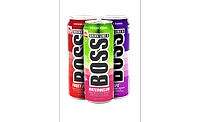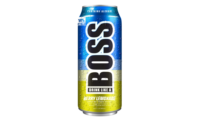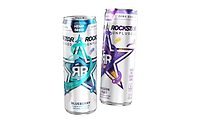Partying Like a Rockstar
By ELIZABETH FUHRMAN
Rockstar has a reason to party, with a brand on fire
and a new agreement with Coca-Cola
When you’re not the inventor of a category, the
way to stand out from the competition is to be an innovator in the
category. That’s where Las Vegas-based Rockstar Inc.’s
President and Chief Executive Officer Russ Weiner’s expertise as an
energy drink consumer came into play.
“I used to drink Red Bull,” he says.
“I’d go out all the time in San Francisco and drink Red Bull
and vodka like everyone else. I remember going out one night and buying two
Red Bulls. It was like $5, but one Red Bull wasn’t enough. I said,
‘You know what. I should make an energy drink.’
“Instead of everyone else in the world that
copied Red Bull with a small 8-ounce can, I said, ‘I’m not
going to do that,’” he continues. “I’m going to
create a 16-ounce, double-sized energy drink and charge the same. I called
it Rockstar – the best name in the whole world – who has more
energy than a rock star?”
Weiner always has been involved in the natural
products industry because of his parent’s work in the health and
nutrition field. His mother Janet Weiner is chief financial officer of
Rockstar, and his father is conservative radio commentator Michael Savage,
who also holds a Ph.D. from the University of California at Berkeley in
epidemiology and nutritional science. Weiner’s entry into the
beverage market came during his run in 1998 for a seat in
California’s state assembly when he met Maurice Kanbar, founder of
Skyy Vodka. Although Weiner lost the election, Kanbar saw a drive in
the young enthusiast that encouraged him to hire Weiner to develop new
products.
During his time working with Kanbar, Weiner came up
with the inspiration for Rockstar. Weiner pitched the idea to Kanbar, but
he wasn’t interested in energy drinks. Instead, Kanbar gave Weiner
his blessing to venture out and use his contacts.
In 1999, Weiner met with Southern Wine and Spirits,
which was Skyy Vodka’s distributor in Northern California. Southern
Wine and Spirits became the first distributor to pick up Rockstar, and
Weiner left to start his own business.
Weiner mortgaged his condo and started his business
with $50,000. Finding a manufacturer who could fill the 16-ounce can took
more than a year. The 16-ounce Rockstar can was first made by Warrenton,
Mo.-based Warrenton Products Inc. Weiner also recruited Jason May,
Rockstar’s marketing executive, from Skyy Vodka to help develop the
design and image for the black Rockstar can with gold, red and white
accents.
Weiner would be the first to say Rockstar is an
image-driven brand. But that doesn’t mean it doesn’t have the
nutritional content to back up the “stronger, faster, bigger”
claims on the can. Rockstar went through 700 formulations before it hit the
market. The product features guarana for its caffeine boost and milk
thistle, which is reputed to assist in liver repairs. These, plus the fact
the company only incorporates top-of-the-line ingredients, is what Weiner
feels sets his energy drink’s sustained energy apart from other
brands.
“Like anything, a vitamin is not a vitamin is
not a vitamin,” Weiner explains. “There are different degrees
of quality and different costs involved with quality. We spend more money
on ingredients because there is enough margin. There was enough margin in
this for me to do a double-sized can, give twice the amount and have more
expensive ingredients.”
‘Super fired up’
Rockstar took off in Northern California, with Costco
accepting the product two months after it launched. Then Albertson’s
and Safeway picked it up, with other chains such as 7-Eleven, AMPM, Circle
K, Longs Drugs and Chevron followed soon after. Once Northern California
was covered, Rockstar moved into the Pacific Northwest, Arizona, Nevada and
Colorado.
Then Rockstar tapped into the Admiral Beverage Corp.,
which consists of a large group of independent Pepsi bottlers, who took the
brand in even though it competed against Pepsi’s Amp. Admiral
Beverage brought Rockstar to Utah, Idaho, Wyoming and Montana. Rockstar,
which had never spent any money on traditional advertising venues, had in
one year steamrolled through the West.
“The problem occurred for us when we tried to go
east of the Rockies, where third-tier distributors doesn’t exist
except for the Turner group, which happened to be in Texas and in the
Midwest,” Weiner explains. Persuading Dr. Pepper/Seven Up Bottling
Group to take the product required the company to first establish itself
with other distributors.
“Russ basically set up in Southern California a
duel distribution system, with Southern Wine and Spirits handling some
channels and Dr. Pepper/Seven Up doing other channels,” says Joey
Cannata, Rockstar’s executive vice president of sales and
distribution. “That really was our inroad with DPSU, and we met with
Jim Turner about a year later and we essentially had all their competitors
lined up, so he saw the value in the item and took it on.”
After covering most of the rest of the United States,
Rockstar still had trouble securing distribution in the Carolinas. Cannata
approached Coca-Cola Bottling Co. Consolidated and the company took on the
product.
Rockstar already had a Coca-Cola distributor in Alaska
called Odom Corp., Cannata says. “Our biggest distribution deal with
Coca-Cola was that we got Coca-Cola United in their Gulf Division, which
allowed us to secure Coke Consolidated a few months later. Consolidated
understood the brand and the value in it and that they needed to have an
entry in their territory.”
When Rockstar had gained distribution through Odom,
United and Consolidated, Weiner knew parent Coca-Cola had to be paying
attention, he says. Weiner appreciated the fact that distribution through
Coca-Cola Enterprises (CCE) would help conquer some of Rockstar’s
distribution challenges.
Last December, Rockstar contacted CCE and spoke with
Terry Marks, president of the North American Business Unit. After three
months of negotiating, Rockstar now has the company as a distributor and
CCE has Rockstar to sell. “The beauty of the Coke deal is that they
are going to get us everywhere we couldn’t be before,” Cannata
says.
Coca-Cola has strong relationships in institutional
and contract accounts such as colleges, universities and cruise ships,
vending machines and cold drink equipment, and they are the real value of
the deal, Cannata adds.
CCE will distribute Rockstar and Full Throttle equally
in all of its territories covered in the distribution agreements in the
United States and Canada except the Northwest and Northern California. This
in turn will give CCE more entries into the category and more space on
retailers’ shelves.
“The combination of Rockstar and Full Throttle
propel us into a strong second place in the growing energy category,”
CCE’s Marks says. “Rockstar’s edgy image and tremendous
popularity combined with our world-class distribution system will give us a
clear advantage with our customers and consumers.”
Under the agreement, Weiner will retain brand
ownership. Coca-Cola and CCE will share profits on Rockstar, but the
companies aren’t disclosing the details. The agreement is multi-year
with right of renewal.
Part of the distribution agreement also includes
Rockstar removing Rockstar Cola from the CCE distribution territories.
Rockstar Cola will be staying on the market in Northern California and in
the Northwest for now, Weiner says.
Most previous distribution deals will be terminated
with Rockstar, but Seven Up Bottling Co. of San Francisco and Admiral
Beverage are among distributors the company is keeping in the Pacific
Northwest and Northern California.
Weiner wanted to keep these two territories in which
its previous distributors built the brand. “This is a very valuable
company right now,” he says. “Even if everything went to hell,
we’d still survive with Northern California and the Northwest, which
is almost half our volume in just those two areas.”
Distributors that are being dropped may be upset, but
Rockstar says their agreements and buyout clauses are being fully honored.
“We understand that these guys helped us grow the brand, but it hit a
point where we couldn’t grow any further unless we had a company like
Coca-Cola, which really has total market share in some areas and strength
with national customers,” Cannata says. “We were never going to
get into some of these big accounts. Now we could potentially be in a
Blockbuster Video, Subway, 24 Hour Fitness, Gold’s Gym, you name it.
It’s like 180 of those types of accounts. If you add all those up and
the exposure level, which drives sales in other chains and independent
stores, that’s the value.”
Rockstar will handle all the marketing of the brand.
Even before the Coca-Cola deal, Rockstar began expanding from its
grassroots/guerrilla marketing methods into a billboard campaign in 18
markets, says Jason May, executive vice president of marketing. Rockstar
also has promotional teams in most cities now.
The company also participates in sponsorships of cars
in the Indy Racing League. Additionally, Rockstar sponsors ultimate
fighters, one of which is Randy Couture, and vehicle fabricator Jesse
Rooke, who is known for his custom motorcycles.
Out of control
In 2004, Rockstar profited from a 155.3 percent spike
in sales in an energy drink category that grew 74 percent last year.
Although the energy category is small in volume, its total value of $2
billion, shows the drinks are high in price. Last year, Rockstar ranked as
the No. 3 energy drink company in the country
behind Red Bull and Hansen Natural Corp.’s Monster. The privately
owned company with more than $100 million in sales in 2004 held 15.7 share
and sold more than 5 million cases, Weiner says. He says the company was
already on track to double its sales this year before the CCE deal was
signed.
“Our percentage of distribution, if you look
outside the West, is so low,” Weiner says. “It’s probably
20 percent. We’re naturally going to go out of control because Coke
is going to sell it into those stores.”
CCE and Coca-Cola will have to build sales of Rockstar
while supporting their own brand Full Throttle. They are similar products
and both are sold in 16-ounce cans. Coca-Cola says the energy drinks have
different target consumers. Full Throttle is aimed largely at blue-collar
males, while Rockstar aims for a younger crowd. Weiner says even though
energy drinks are consumed by a wide range of consumers, particularly in
Europe, everyone’s target in the United States is the same: 20- to
30-year-old blue collar males.
“In fact, the No. 1 time for the highest sales
of Rockstar for 7-Eleven in Texas is 7 a.m. to 8 a.m.,” Weiner says.
While energy drinks are beginning to compete with
coffee and soft drinks for a morning, afternoon or evening pick-me-up,
Weiner still sees Rockstar’s driving factor in a different light.
“Energy drinks are a status drink,” Weiner
says. “… It’s a brand drink,
because it’s expensive. No one coughs up $2 plus for soda. People
make a real decision when they are spending that much money for a
drink.”
Rockstar now offers the brand in multiple sizes. After
the release of Diet Rockstar in a 16-ounce white can in 2003, the company
released smaller 8.4-ounce cans in Original and Diet later that year. This
March, Rockstar further expanded its selection by offering a 24-ounce Diet
and Original Rockstar for $3 a can. “We didn’t know if it would
cannibalize sales of the 16-ounce Rockstar, but it’s not,”
Weiner says. “On the West Coast in AMPM, Rockstar’s 24-ounce can is the No. 1 new
item.”
With the removal of Rockstar Cola from some markets,
Rockstar adds two new image-driven SKUs through a licensing agreement with
Von Dutch. The new upscale clothing line’s branded energy drinks will
hit shelves by early fall in a regular and sugar-free 16-ounce can
varieties.
With the hope to grow Rockstar sales in Texas, the
Midwest and East Coast, and even in its more mature markets, Rockstar will
be going into Canada this summer and has plans to expand into Europe this
year, Weiner says.
Weiner, who just turned 35 in May, says he has no
plans to sell the company he worked to build. “It keeps me motivated
and happy,” he says. “It’s very hard to come up with
another big hit, so if I sold this company, then what? I want to work and
still build. My goal is to be the No. 1 energy
drink in the United States.” BI



